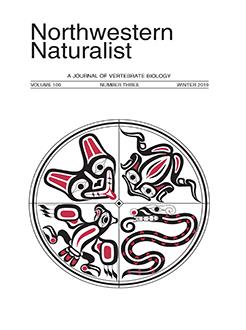Joanne P Schuett-Hames, Dave E Schuett-Hames, F Teal Waterstrat, Eric M Lund
Northwestern Naturalist 100 (3), 186-197, (6 December 2019) https://doi.org/10.1898/1051-1733-100.3.186
KEYWORDS: amphibians, development, MIGRATIONS, movement timing, Pacific Northwest, road ecology, traffic, Wetlands
In this exploratory study, we investigated amphibian movement across a new 1.4-km residential road system adjacent to a wetland complex in Thurston County, Washington. We implemented this study prior to home construction, and before traffic levels associated with occupancy occurred. Our purpose was to document pond-breeding amphibian movement patterns to identify safe-crossing recommendations. One 24-h walking survey was conducted per month from October to December 2008, and in February 2009. We observed 7 native amphibian species and tallied 225 amphibian observations. The data showed differences in autumn to winter migration timing and direction relative to the wetland complex among species, sexes, and life stages. Most adults were moving toward the wetlands, whereas most juveniles were moving away. The highest number of observations occurred during the 00:00 to 03:59 h dark interval, corresponding with lowest local traffic volume. Nearly all observations for Northern Red-legged Frog (Rana aurora), Pacific Treefrog (Hyliola regilla), Long-toed Salamander (Ambystoma macrodactylum), and Northwestern Salamander (Ambystoma gracile) occurred after dark. However, Rough-skinned Newt (Taricha granulosa) peak movement occurred during daylight, corresponding with the highest traffic volume. We documented diffuse movement throughout the road system. Spatial analyses highlighted 2 significant crossing hot spots, including a 1.8-m diameter culvert. This study illustrates the importance of understanding the spatial and temporal patterns in pond-breeding amphibian migrations to effectively plan and implement measures to reduce amphibian road mortality. Prior to new development, we encourage proactive planning, such as connectivity, traffic, and traffic calming analyses to identify amphibian migration locations and reduce mortality. In areas with existing roads, such as the study site, we suggest implementation of mitigation measures paired with effectiveness monitoring.


